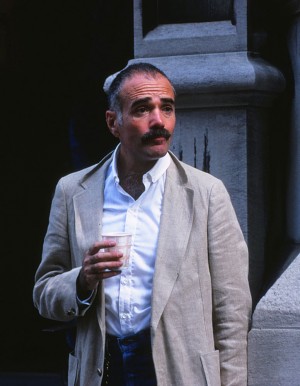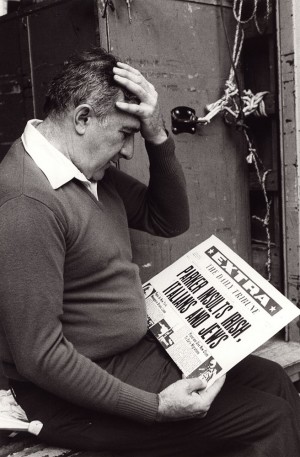Fame
The making of the film by Alan Parker
“Piss off, and take your stupid TV series with you.” So said Alan Marshall, my choleric London producing partner of many years, to David De Silva, his New York co-producer on Fame (who, to be honest, he found something of a pest). It was probably the most expensive “Piss off” in cinematic history as the TV series we were not part of, went on to make $300 million dollars on syndicated television. To be accurate, at that point when Marshall told Da Silva to get lost — some months before we started shooting — the project was not called ‘Fame’ at all, but ‘Hot Lunch’.
From the start, Marshall and De Silva were not comfortable bedfellows, being very different personalities: De Silva, the cerebral, introspective New York theatre person and Alan Marshall the gruff, take-no-prisoners, film pro from north London.
Annoying as he might have been to Alan Marshall, De Silva was entirely responsible for the genesis of the project. He had been taken by the lyrics of a song in “A Chorus Line”, the Michael Bennett smash Broadway success at the time. The song, “Nothing”, had mentioned “PA”, the High School for the Performing Arts on 46th Street, and alluded to acting classes where, unlike the other kids, the character Morales doesn’t quite “feel the motion” of a bob sled in the snow — understandable being as she is from San Juan; and so she feels ”nothing”, which becomes her mantra and nickname.

Producer, Alan Marshall
De Silva left the theatre with the notion that there was perhaps a script in a pre-Chorus Line story that explored the lives of wannabe performers during the delicate, formative years before life as a Broadway gypsy. So to give old De Silva his due, he did start the whole thing off, although, to be honest, he had very little to do with the making of the actual film. Years later, as the endless stage versions trundled across the globe, he dubbed himself in ads with the moniker: ‘the father of Fame’. More accurately he was the father of ‘Hot Lunch’.
De Silva, a theatrical agent, had originally hired Christopher Gore in 1977 to write a screenplay based on the High School for the Performing Arts. Christopher had previously been a Broadway librettist (‘Via Galactica’) and De Silva paid him $5,000 for a first draft. Christopher spent some time with a few of the students and came up with his script, which De Silva niftily sold to MGM for a considerable profit.
Having had some success with my previous film Midnight Express I was suddenly inundated with Hollywood scripts. (What my mentor Fred Zinnemann called “the first bounce when you’re hot”. When you get “less hot” in Hollywood you receive scripts on their fourth and fifth bounce —the scripts arrive covered in other directors’ fingerprints.) Alan Marshall and I found ourselves in Los Angeles at a pool room bar called Barney’s Beanery where, killing time before a meeting, we read two of the scripts sent to us: ‘Hot Lunch’ by Christopher Gore and Armyan Bernstein’s excellent ‘One from the Heart’, (eventually made by Francis Coppola). ‘Hot Lunch’ was by far the cruder of the two but I was attracted to the flip side of the American Dream; the eight main characters and particularly the eccentric milieu of this curious school, which at the time I never even knew existed. Also I always wanted to make a film in New York —my first film in America— and so I found myself sitting opposite David De Silva at Elaine’s restaurant in Manahattan. We didn’t get off to a very good start because, after mentioning that I would like to write my own version of the script and that I would be making the film with Alan Marshall producing not him, he began to cry. I tried to console him as he blew into his napkin. At the time it was impossible for me to know that “Fame” would eventually become his life’s work occupying the next thirty years during which he would gain his revenge by becoming very rich from the TV and particularly, the licensed Stage versions of my film.
After settling my family in nearby Greenwich, Connecticut and setting up our production offices at the Paramount Building on Times Square, I became a regular visitor to the school.
Unobtrusively tucked away in the middle of a non-descript block on 46th Street, Manhattan’s High School for the Performing Arts was appropriately just two minutes from Times Square and the great white way of Broadway. I remember on my first visit seeing young Gennadi Filiminov in the stairwell playing his violin. He liked the acoustics there and I took a photograph of him that eventually became the cover of the script. It was hard not to be impressed by the kids at the school, even if the shabby, neglected building was less than inviting. A lot of the kids were misfits, refugees from tougher New York schools and had found sanctuary, and an odd camaraderie, at PA. Considering the extraordinary social and ethnic mix, everyone seemed to get along. No one could remember a single fight or racial problem—they were probably all too occupied by their own ambitions and goals and channeled their energies into that. Not that it’s an easy school to be at. As part of the regular NY schools system they had to attend to their own discipline in the mornings— be it drama, dance or music —and still cope with their normal lessons, just like any other high school.
There is a theory amongst French critics that a director makes twenty versions of the same movie throughout his or her career. However, I have always tried to do something different each time out of the blocks. Although a puckish journalist at the time suggested, ”Alan Parker specializes in films about incarceration: first a film about Turkish prisons and now a musical about an American high school.”
Fame represented a huge leap away from Midnight Express in mood and content. It was not meant to be a nuts and bolts documentary about the High School for the Performing Arts — rather a theatrical vision of life at the school: a fusion of observation and fiction: a hard look at a subject which had traditionally been over glamorized. Consequently I spent a lot of time hanging out with the kids over the months: gradually incorporating many of their stories into my new draft of the screenplay. I wasn’t a New Yorker but I felt at home in the city. Sometimes when you’re one yard outside of a society, or culture, you tend to look at that world slightly differently from those who are immersed in it— things so easilly taken for granted, can perhaps be seen with fresh eyes.
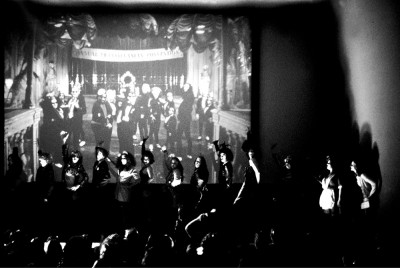
“Just a jump to the left and a step to the right.” The Time Warp, Rocky Horror Picture Show, 8th Street Playhouse
The lunch-room at PA was my favorite place to hang out, talk and listen to the kids: their lives a littany of humiliation and rejection at cattle calls; their healing cruciate ligaments, calloused finger pads, latest crushes and impending nervous breakdowns. It was quite common to sit opposite a kid playing a cello, next to a dancer with her leg behind her ear, with another kid jamming on the piano in the corner while half a dozen erstwhile Stanley Kowalski’s belted out their lines to imaginary Blanches. All of this went into the script. They hauled me along to the 8th Street Playhouse for a midnight re-run of The Rocky Horror Show where I watched them re-enact the whole show, dressed as the movie’s characters — squirting water pistols in the air when it rained; answering back to the screen from an unwritten audience created script, culminating with them jumping on stage to join in the ‘Time Warp’ dance routine, with the actors on the screen flickering behind them. It was great spontaneous theater that I had to include in the film.
I had promised the kids at the School of Performing Arts that they would get first chance at all the roles in the film, but explained that I would also be casting the net as widely as possible. Howard Feuer and Margie Simkin were taken on as casting directors and I drove them nuts over the next four months as we assembled our cast. We had an ‘open call’ for actors, singers, dancers and musicians at the Diplomat Hotel on 43rd Street and over 2,000 young hopefuls turned up: to be assessed and put through their paces. The day went like a military exercise and I taped the hundreds that filtered through to me clutching their yellow ticket for a ‘call-back’. There’s a story that Madonna, as a 21 year old New York showbiz wannabe, stood in line outside the Diplomat but I think it’s apocryphal. We also exhausted the conventional avenues of casting kids with agents plus every acting, dance and music school in New York. My office walls were filled with a thousand Polaroids as I tried to narrow things down to a workable cast. Even if someone didn’t make it to the principal cast I could move him or her to the background, handpicking everyone seen in the film. The auditions scenes in the film allowed me the opportunity to use many of the more eccentric performers (like Isaac Mizrahi, the dress designer, who was a student at PA at the time, and appears in the film as a crazed Shakespearean jester.)
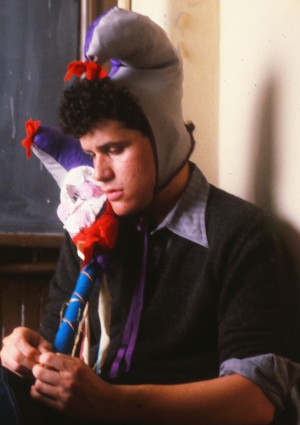
Isaac Mizrahi as Touchstone in As You Like It in the audition sequence
We had originally intended to use the shabby but appealing (as in peeling paint) PA building as our location but this request received an emphatic ’no’ from the New York Board of Education. It was suggested that I should personally visit the ‘Board of Ed’ in order to put our case. I sat in front of a group of stern looking people as I unctuously spouted the ‘our film will be wonderful’ routine and that it would put the school on the map. The formidable head of the board — an obdurate, self-important woman with steel gray hair and half frame glasses — promptly told me that their school had been on the map for forty years and already had hundreds more applicants than they could admit, and so publicity was the last thing they needed.
“Does there have to be so much profanity?”, snapped another board member, waving a well-thumbed copy of an early draft of our script. “No one in our school system speaks this way. “
“Like fuck they do,” whispered Alan Marshall sitting beside me..
“It would be a quality film.” I assured the flinty harridan behind the long oak table, but it did nothing to mollify her disrelish. She looked at me over her glasses and uttered a line I will always remember: “Mr. Parker, I can’t risk you doing for New York High Schools the same thing you did for the reputations of Turkish prisons in your last film (Midnight Express).”
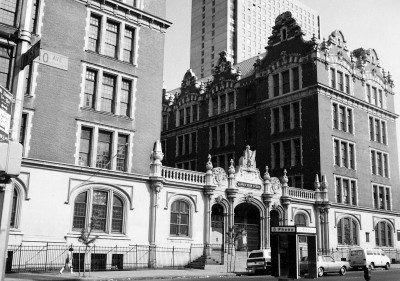
Haaren High, the magnificent giant high school on 10th Avenue — totally empty it became our own private film studio.
We solved the problem by finding two empty schools where we could rebuild, paint (or un-paint) and dress our sets. The largest of these was a mammoth school called Haaren High on 59th and 10th, which became a virtual studio for us, housing workshops, as well as our sets. At the other end of town, on 9th Street and First, we used another empty school for the staircases and dance rooms that reflected the smaller PA. Opposite to the real PA school on 46th street was St Mary’s Baptist Church, and this became the entrance to the school seen in the film.
Our difficulties with the Board of Education found their way into the press, which is always unhelpful at such an inchoate stage on a film and this made us extra sensitive. To cap it all, I was in a taxi going down 8th Avenue and saw a marquee for a porn film called ‘Hot Lunch’. It was pointed out to me more than once that, in some quarters, a ‘hot lunch’ was New York slang for oral sex. I was also waggishly informed that the biggest star in porn films at the time was a gentleman called Al Parker. We decided to change the title.
The studio in Los Angeles sent a list of alternative titles among which were: Neon Dreams; Break a Leg; Spotlight; Shooting Stars; Stagestruck; Pizzazz and Razzle Dazzle. I spent some time in Connecticut completing my draft of the screenplay incorporating the hundreds of scenes and snatches of dialogue I had accumulated whilst hanging out with the kids at PA. Still short of a title, my hefty, 171page script was distributed to the crew with a front page that merely said, “TITLE”. It was three weeks into filming before I came up with the films final title ‘Fame’. David Bowie reminded me much later that I nicked it from a song he wrote with John Lennon, which could probably be true.
I had originally approached Georgio Moroder (who had done the score of Midnight Express) to do the music, but he was busy on a new Donna Summer album. I also asked Jeff Lynne of the ELO, who were very big in the US at the time, but he declined. We had originally hired Michael Gore (no relation to Christopher Gore), as ‘music co-coordinator’. Michael was a Yale trained musician straddling both classical and rock having been Leonard Bernstein’s protégé, as the pianist on ‘Mass’ — and he’d also contributed to his sister Leslie Gore’s seminal hit record “It’s my party and I’ll cry if I want to” on which he’d played piano, aged twelve. I had promised Michael a crack at the original compositions we needed if we hit the shallows in finding a composer. He teamed up with lyricist, Dean Pitchford and eventually wrote five songs for the film including the title song ‘Fame’ and ‘Out Here on my own’—also Oscar nominated—which he wrote with sister Leslie.
I had decided that all the music and musical numbers should work organically — evolving from real situations and not feel phony by suspending belief as in a traditional Hollywood musical: “Hey, let’s stop the story while we put on a show and have a musical number”, kind of a way. Also no one was to be dubbed — voices or musical instruments — so that things would be as genuine, realistic and authentic as possible. (However, I did ‘juice up’ Bruno’s solo electric keyboard audition by throwing in the Berlin Philarmonic.)

Antonia Franceschi (Hilary) and Gene Anthony Ray (Leroy)
Before we started shooting we had blocked out studio recording time in order to lay down tracks for the pre-recorded songs and to improvise the ‘Hot Lunch’ number. This song evolved from an all day session involving groups of kids from all disciplines, as we cobbled together the song with everyone chipping in their contributions. My Assistant Director, Robert Colesberry (who went on to produce three further films for me) came up with half a line, for which he went on to receive handsome royalty checks for years to come. His stellar contribution: “If it’s blue it must be stew, if it’s yellow, then it’s Jello.” Not exactly Irving Berlin.
I had also, along the way, combined Music & Art, the sister school to PA, into our movie’s fictitious school. I had visited M & A in Harlem and it was impressive listening to a gospel ensemble and then, following the same kids into their next class, heard a wonderful rendition of Rossini’s ‘Stabat Mater’, which I put into the film.
I had engaged Louis Falco as choreographer. Louis had his own dance company in New York and also had created works for many of America’s principal dance companies. As with the music, we wanted the dance to appear spontaneous, and to evolve naturally so that none of the numbers looked staged— rather that these exceptional kids were doing their own thing — a sort of choreographed bedlam. The wonderful thing about the effortlessly creative and anarchic Louis, was his flexibility and lack of preciousness about his work. We had six weeks to rehearse the dancers and each day he would show me his kinetic routines. I would ask for small changes for the camera and he would immediately adjust the work, often involving thirty dancers. Unlike the old MGM masters, or more recent masters like Bob Fosse for that matter, we didn’t always choreograph the camera movements for the numbers. We’d been blessed with a wonderful group of kids and I didn’t want to inhibit them, or lose their spirit, by making them hit marks. I wanted it to appear that no outside hands were at work to hinder the naturalism.
At the end of four months of preparation Alan Marshall pointed out that the longer I stretched out the casting process, the less time we would have for rehearsal. Casting any film is always traumatic —get the casting wrong and you’re more than likely to get the film wrong— but you’re never sure that someone else will walk through the door that day who is even better for a role that you’ve already cast. Gene Anthony Ray was cast that way, at the last minute. Margie Simkin had found him break dancing on a street corner in Harlem and he came in to read with me. Supremely confident, he said, ”This isn’t hard for me to play. On 153rd Street and Eighth Avenue there’s nothing but Leroys.” He had won a number of disco awards previously and Louis Falco loved his raw talent and choreographed to Gene’s strengths.
Barry Miller (Ralph) had previously played John Travolta’s suicidal friend in Saturday Night Fever. I was casting against type, Barry being Jewish not Puerto Rican. He was a complex young man—he’d been a child actor, managed by his mother — but his surly persona masked a considerable talent.
Laura Dean (Lisa) curiously was the only current student at Performing Arts to get a principal role even though I had read with, as promised, the entire student body. The school, instructed by the Board of Ed, had initially blocked their students from being in the film claiming it would take time away from their studies. However we planned to shoot the bulk of the film through the summer vacation period when the kids were out of school thus avoiding the limitations on the hours worked under the rigid New York child labor laws. Consequently most of the extras we used in the film were from the actual school for the Performing Arts.
I was originally interested in Irene Cara for her frail but pretty looks and her acting (she had been in Roots II). Although she had done some back-up singing and, outside of some a cappella stuff in my office, I wasn’t entirely convinced about her and so I asked Michael Gore to work with her in the studio. Afterwards, he phoned me with a simple message, “Boy, has she got the chops.” Like me he was pleasantly surprised how good she was — her great voice was almost a bonus as we had prepared to work with a lot less. It’s fair to say that the character Coco’s unbridled ambition in our story, closely mirrored Irene’s in real life. In fact the eight main characters all resemble the characters they play — although I’m sure all of them would all be loath to admit it.
I found Lee Curreri (Bruno) at the Manhattan School of Music and Antonia Franceschi at the school of American Ballet. She had started with Alvin Ailey when she was eight and fitted the part of Hilary perfectly.
Paul McCrane (Montgomery) had come in to read for me and hauled along his guitar. I asked if he’d play for me and he sung one of his own songs: “Is it OK if I call you mine”, which I included in the film — as Montgomery sits perched in his apartment window high above the flickering neon of Time Square.
Maureen Teefy (Doris) was also cast against type. I suppose I was trying to avoid the NY Jewish stereotype, as she was Irish from Minneapolis and no Jewish princess.
We started filming July 9th, 1979 for a scheduled eighteen-week shoot. I had with me the kernel of my British crew who I had worked with for many years: Producer Alan Marshall, Cinematographer Michael Seresin; Production Designer, Geoffrey Kirkland; Editor Gerry Hambling and Camera Operator, John Stanier. In order to gain work permits for the British crewmembers we had to pay the price by doubling up with New York union people and consequently we were considerably overstaffed. Also, new to us, everyone had a truck. We had more trucks than Rommel. The fact that we were shooting in one of the busiest most congested cities in the world made no difference to such a cumbrous modus operandi. Each department had a truck, or often many trucks, each one the size of Macy’s and each one with a couple of teamsters to look after it.
Before we started I wrote my customary letter to the crew, which contained the following paragraph:
Our film I hope will be a microcosm of New York. It’s the glamour of the Great White Way of Broadway and the squalor of 42nd street; the dream of instant success and the constant reminder of failure; the fine line between a Julliard scholarship and dancing topless at the Metropole. It’s George M. Cohen and the City Ballet. Lieber & Stoller and Vivaldi. It’s New York: vulgar and beautiful. A dozen races pitching in each having their own shot at the American dream.
We filmed a civilized five-day week, which allowed for weekend visits to my family in Connecticut. Despite the excitement of shooting in Manhattan I can’t say that the filming was totally pleasurable. It was one of the hottest summers on record, the tar melted under your feet as you crossed the New York streets and our shirts were constantly hanging from our bodies, ringing wet.
Working with an American crew for the first time was also an experience that had its ups and downs. We shot faster than they were used to, and consequently the slumbrous crew, endlessly camped out by their trucks along the New York sidewalks, had to be yanked along with us as they adjusted to our momentum.
Certainly, we had made a rod for our own backs by insisting on bringing in our key British personnel — now normal, this was a new phenomenon to the historically protectionist New York film unions and created its own tensions and resentments amongst the New York crew, many of whom were quite surprised to hear that people actually made films outside of the USA. Coming supposedly from “strike torn Britain” it was also a shock to be confronted with much tougher union regulations and more draconian work practices among the American film crews then we were used to back home.
It was our custom to Polaroid costumes, casting, props etc for everyone’s reference, which was a new phenomenon for New York film crews who at the time were oddly unaccustomed to Mr. Land’s invention being used so frequently on a film set. The camera union consequently threw in a spanner by insisting that only the set stills photographer was allowed to take Polaroids. As the union allocated stills ‘photographer’ had a hard enough job keeping her own Nikon in focus, this led to the ludicrous employment of a separate camera union person to take every Polaroid for each department—costumes, art department, props etc. Even the union officials eventually realized this silly mandate was as impractical as it was foolish and relented — and so everyone was allowed to take their own Polaroids.
The European style of single source, diffused light — dubbed ‘Le Lumiere Anglais’ in France, was also a puzzlement to the American crew. For many years in Europe, we had used smoke in scenes to diffuse the light. Traditionally incense burners were used to puff the soft smoke into the air to catch the shafts of light, but this presented problems for some of the New York crew who were steadfastly set in their ways. Firstly, the props department and the lighting crew couldn’t agree on who was actually responsible for this new task of igniting the pellets and puffing away with the small hand-bellows before each shot. Secondly, a number of the crew (and actors) were appalled by the presence of the smoke and complained to their unions about the “noxious” working conditions. We were duly visited by representatives from the SAG and Local 644 who promptly called a halt to filming in conditions ‘possibly hazardous to their members’ health.’ We pointed out that we had been using incense on sets in England for many years, but not nearly as long as the Catholic Church who, with the exact same smoke, had according to the New York crew, apparently been asphyxiating their congregations for two millennia. Our argument was mute as SAG and Local 644 countered that they had no jurisdiction in the Vatican, but they did on a New York City film set and so the smoke was forbidden and we reluctantly abandoned the procedure in order to be allowed to continue filming.
Some aspects of filming were better than we had encountered in England. The enormous crew meant that there were “runners” everywhere to perform the smallest chore. It seemed to us coming from frugal Britain, if you employ anyone in the states, the first thing they will do is to employ an assistant. Chances are that the assistant will also take on an assistant. This, sensibly, makes for full employment and a very overcrowed and busy film set.
The use of machinery of every kind to solve the simplest task was an eye-opener, as was the way the crew communicated to one another with walkie-talkies which made for a more civilized film set — devoid of the customary migraine inducing cacophony of parade-ground ‘sergeant major’ bellowing experienced on a British film set.
However, a new word was introduced to me — “Grandstanding”. This was when personnel from each department let it be known that it was now their moment in the sun. Jobs that were quietly and invisibly performed in England for the show suddenly were the show. This was usually led by the diva-ish sound department who, dressed in their ‘T’ shirts proclaiming “My kid’s Dad won an Oscar”, regularly took over the entire set with great pomp and noisy braggadocio, to lay their microphone traps. I learned quickly that in America the fundamental rule of life is that it’s not enough to do the job, but you have to be seen to do the job.
We had rehearsed the music and dance scenes for six weeks before the start of shooting and these went well—made pleasurable by the indefatigable spirit of the kids and Louis Falco and Michael Gore’s incredible enthusiasm and willingness to please.
Kristi Zea our costume designer took her inspiration from the kids’ own unique style, by pushing it to the limit and embracing a wacky mix of Broadway dance gypsy, showbiz glitz and second-hand Bowery thrift which eventually begat a whole fashion look. Because I had been casting right up to the wire it had left me a scant two weeks for drama rehearsals, which was probably a mistake and I found my usual patience stretched to the limit as I harboured injurious thoughts toward a couple of my main cast. To be frank, directing young people is not something I get pleasure from even though it might seem so, considering the amount of work I’ve done in this area. In my previous film, Midnight Express I could take an actor like Brad Davis or John Hurt aside and explain what I needed and be pretty certain they could deliver each time. Nearly all (but not all) of these kids were extremely self-obsessed, capricious and irritating to work with. Also the fluctuations in their performances, enthusiasm and energy levels took me by surprise. It took me a long time to realize in New York that when an actor went off to “do a line” they weren’t going over the script. To get the proper responses from the players I had to be father confessor, older brother, demanding schoolteacher and maniacal despot. I would have to wear a different hat each day depending on which actor I was directing. I had chosen the kids largely because their own personalities were close to the characters they were portraying, and they often lacked the basic skills to make my job easier. With such young performers their approach is often more intuitive than it is intellectual. Irene Cara and Barry Miller were the most difficult — Irene, because she “fluctuated” the most being more comfortable in a recording studio, and Barry because he appeared to be full of fear and hidden demons. This manifested itself in a surly, bratty awkwardness that drove the crew nuts. There were three scenes where Barry had to break down and each one was traumatic. Pinned up at the school on 46th street was a hand painted sign that said, “Pain is part of creating” and it had become a mantra for the feral Barry Miller. I pushed Barry, over two long nights, in the dramatic scene in Montgomery’s apartment as I tried to ratchet up the emotional stakes. He was a talented actor and a great deal of the pain and emotion that he reached for were his own, as I selfishly, almost sadistically, repeated the scene over and over. In such circumstances, the results can be spectacular however tortuous, but I have often chastised myself as I got older for the psychological damage a director can inflict on an actor — all in the name of a ‘great take’.
At the end of each day we would view our dailies. I invited the whole crew, as was custom on my films, and gradually more and more would turn up to see their work. Many however stayed away as they had grown up under a system where only the studio, director and producer were ever allowed to see the dailies. Also, more to the point, In New York they considered attendance at such screenings to be unpaid overtime which was a less than attractive proposition.

Bob Colesberry, Alan Parker, Sal Piro, The ‘Rocky Horror Picture Show’ sequence, at the 8th Street Playhouse, New York
One of the more enjoyable scenes to shoot was at the 8th Street Playhouse where we filmed the audience involved with the on-screen Rocky Horror Show. We were lucky to have Sal Piro, who was the compere and main instagator/creator of the original idea of audience participation with the film. What began as a funky banter at midnight screenings — reacting vocally to kitch lines — had developed into a full scale, highly eccentric, theatrical event. Now, everyone dressed in costume and communally blurted out their now finely honed, audience invented script.
Our biggest logistical challenge on Fame was the musical pandemonium outside the school where the kids flood into the 46th street traffic, creating anarchic musical mayhem. Louis had choreographed eight different routines which he allocated amongst his dancers. We then randomly sprinkled the fifty dancers among 150 regular kids — the non-dancers — to raise the quality of the bedlam and achieve the choreographed chaos we were after. Certainly we were pushing reality to the extreme in that it doesn’t normally happen, but on the other hand there was always the chance that it could happen.
We had allocated three days to shoot the whole sequence and had extraordinary co-operation from the Mayor’s Office and the NYPD. The evening before the big day we were shaken by the news that my camera operator, John Stanier, had returned to England for personal reasons. We limped along for an hour or two on the first day with DP Michael Seresin operating, until we were “visited” by the 644 camera union local. Filming was suddenly stopped and the crew froze as a large black limousine pulled up in the middle of 46th street and out climbed a posse of union representatives, all absurdly dressed in black suits with pork-pie hats and dark glasses. (Hard to believe, but true). We were told that the DP was forbidden to operate and that we would only be allowed to continue filming if we took on an operator from their union. The alternative was that they would close us down permanently.
Within an hour we had resumed filming with a cocky, captious New Yorker as replacement operator, who managed to throw spanners into every shot, impeding our momentum, but we soldiered on.
The song ‘Fame’ hadn’t been written at this point and the whole scene was shot to playback using Donna Summer’s ‘Hot Stuff’. The new ‘Fame’ song was written and recorded later and layed on during the editing.
The upside of the three days was that my assistant director Bob Colesberry — imperious among the insanity and crackling of fifty walkie-talkies — marshaled the enormous cast and crew with all the authority of the Vietnam platoon commander he had once been, only a few years before. On the second day the NYPD said that we had caused such traffic back-ups that they were seriously cutting down our shooting day by removing their traffic control after 4 o’clock. We patiently put together the shots I had planned as we coped with a mammoth camera crane, a laborious, belligerent camera crew and an increasingly complaining cast. No sooner had we started on the second day and the dancers went on strike. Galvanized by the presence of the men in black pork pie hats their own ‘dancers union’ representatives also visited the set and demanded “stunt” adjustment money for their members to dance on top of the taxicabs, to be added to their $100 a day dance pay. I left the stoical Alan Marshall to haggle with the union reps in the middle of the street, wondering whether he had broken a mirror.
I have a nightmare memory of sitting on an aluminium camera box on the 46th street sidewalk, no longer angry, but full of fear, looking at the traffic jam we had caused as far as the Hudson River, wondering how the hell I was ever going to complete the scene. How would we ever finish? As always on a film the great adversary is not parsimonious, meddling studios, caviling producers or syphilitic, snorting actors, but the ticking of the clock. For a director, ‘Time’ is the great enemy, the eternal gut wrencher, and there’s never enough of it. Each day, in the heat of battle, I wondered why I put myself through the perverse masochistic act of shooting in the centre of a real city. It was so much easier in the old days when they shot these kinds of scenes on the back-lot, or even inside a stage at MGM. Miraculously, three tortuous days after the scene came to an end.
That evening, co-incidentally, my friend the producer, David Picker arranged dinner with one of my heroes, the great Bob Fosse. Fosse squeezed my hand and poured me a large glass of wine as I miserably recounted my day’s work on 46th Street, convinced as I was that I would soon be on the plane back to London, never again be entrusted with a film with music. Or even one without music.
Faced with the dilemma of our missing operator, I brought in Garrett Brown from Philadelphia. Garrett’s claim to fame being that he invented the Steadicam and I had met him in England whilst visiting the set of Stanley Kubrick’s The Shining.

Camera Operator, Garrett Brown with his invention, the Steadicam, filming Doris and Ralph on the New York subway.
The ‘Steadicam’, which has become standard equipment on most movies, is a camera mount — a system of balances and gyros that can be strapped to an operator’s vest —achieving perfectly smooth tracking shots, without the need for a cumbersome wheeled dolly. This allows for wonderfullly fluid movement of the camera in places no dolly could get to. Although widely used across the world, Garrett was still the greatest exponent of his own invention. We were able to film a prolonged, complicated shot on the subway with a continuous dialogue sequence involving an arriving train, all perfectly timed for the scene between Doris and Ralph (Maureen Teefy and Barry Milller).
Listening to Donna Summer and ‘Hot Stuff’ for three days had inspired Michael Gore to write a new song which would carry the film’s new title: Fame. In the empty music room at Haaren High he sat down at the piano and banged out the new song for me. As brilliant a musician and pianist as Michael is, his singing voice is more Noel Coward than Otis Redding and I consequently thought the new song was pretty awful. “I’m gonna live forever, baby remember my name” he shouted with gusto. Oh boy, I thought. Who would listen to that? We agreed to lay it down properly with Irene singing, before my hasty judgment committed it to the ‘out’ tray. Suffice to say that it came out a lot better in the studio.
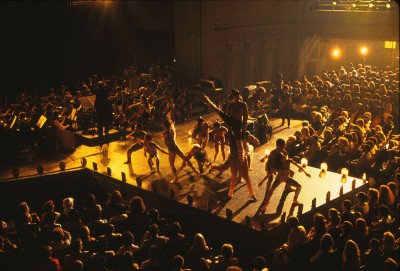
The ‘Body Electric’ end number written by Michael Gore and Dean Pitchford (with a little help from Jeff Lynn), choreographed by Louis Falco and filmed at Haaren High School, 59th Street, New York
The concluding number in the film was written to my brief allowing for a 70 piece orchestra, rock band, gospel choir, dance break, and various solo singers. The inspiration for what became ‘I sing the body electric’ was the Jeff Lynn ELO song ‘Eldorado’ which I had been playing over and over whilst writing the script in Connecticut. Dean Pitchford took his title from the American poet Walt Whitman’s ‘I sing the body electric’ from the ‘Leaves of Grass’ poems.
After 91 shooting days in Manhattan, Brooklyn and the Bronx we finished on schedule, give or take an hour or two, and on budget ($8,500,000).
Afterwards
The film went on to win two Oscars and spawn many copies, not to mention a worldwide fashion in legwarmers. In Academy Awards history it was the first time that two songs were nominated from the same film. (‘Fame’ and ‘Out here on my own’). Gerry Hambling was also nominated for editing but didn’t win. His brilliant work was one of the most important aspects of the finished film— a fact recognized by his fellow editors at A.C.E. who gave him their annual award to make amends for the Academy’s omission.
On the evening of the film’s extravagant world premiere that MGM put on at at The Dome cinema in Los Angeles, the projectionist loaded the film incorrectly, forgetting to lock the spindle. Consequently, in the middle of the ‘Hot Lunch’ number, the large reel shuffled along the spindle and fell off the projector, crashing ignominiously onto the floor. The lights went up and it took ten minutes to start the film again. After recklessly attempting ‘unlawful personal violence upon another person’, namely the projectionist, I looked for the nearest bar with Michael Seresin, and returned two hours later. I was told that projector mishaps were not uncommon at Hollywood premieres and was thought to be a good omen. Curiously, in a city where everyone wants to be in movies, absolutely no one wants to be a projectionist.
As the wily David De Silva had cunningly predicted, NBC did the spin off TV series, which became a big success. Personally I thought it meretricious and tacky, However Alan Marshall candidly pointed out that perhaps I would have felt a tad less bilious and more generous if we had participated in the subsequent profits — which we didn’t.. (Initially the TV show flopped in America, canned after a year, but was resurrected in syndication where it topped the ratings in 68 countries— pulling audiences of 11 million in Britain alone. Mr. De Silva became very wealthy and continues to license the vapid stage show around the world.)
Significantly, and perhaps reflecting the freewheeling New York arts and gay scene of the seventies, Louis Falco (choreographer), Christopher Gore (writer), Barry Gornel (Assistant choreographer) and Gene Anthony Ray (Leroy) all died of AIDS. Gene’s mother was jailed in 1984 for running a drug ring. He had gone to Milan to start a Fame type school and was arrested stealing a bottle of wine from a supermarket. He had alcohol and drug difficulties.
Irene Cara spent the following years endlessly singing the “Fame” song and it’s clone ‘Got a feeling’ from ‘Flashdance” on any show that would have her. “Saturday Night Live” did a great pastiche with their own lyrics to the Fame tune, called “SAME” — “Every time it’s the same song”.
Paul McCrane went on to do ER (without hair); Antonia Fraceschi joined New York City Ballet as a principal dancer; Lee Curreri had a career with the TV spin-off versions of the film and became a music producer.
One of the most significant contributors to Fame was Robert Colesberry, my assistant director, who went on to produce three further films for me (Mississippi Burning, Come See the Paradise, The Road to Wellville) and also films for Scorsese, Schlondorff, Ang Lee, Levinson, and also the seminal TV series The Wire. He died in 2004.
The film inspired the creation of many similar schools around the world (including LIPA in Liverpool, based in Paul McCartney’s old school). Performing Arts schools opened in a dozen cities across the United States from Cleveland to Milwaukee and Phoenix to Baltimore. In New York, flushed with a new world-wide celebrity, PA was moved from its grungy building on 46th street, where it had been for fifty years, and in 1984 (combined with Music & Art) moved to a spanking new, nine story building in Lincoln Centre. The NY Board of Education, who had been so discouraging and unhelpful to me when I made the film, now on their website, proudly refer to the new haughtily named, ‘Fiorello H. LaGuardia High School of Music & Art and Performing Art’s as “the Fame school”.
Original Production notes 1980, and subsequently published in the Sunday Telegraph, 2009.
After, Afterwards

The iconic Fame logo was designed by British graphic designer John Gorham
Reading these notes I am struck by the difficulties with the unions — the like of which I never encountered again on my many American movies. I think that we were the first European filmmakers to encounter a very parochial mentality— a protective wall originally errected as a bastion against Los Angeles, rather than Europe, and hence the exaggerated difficulties. Everything has changed now, as filmmaking has become more global, filmmakers tend to move between countries with equal reciprocity, working with comparative ease.
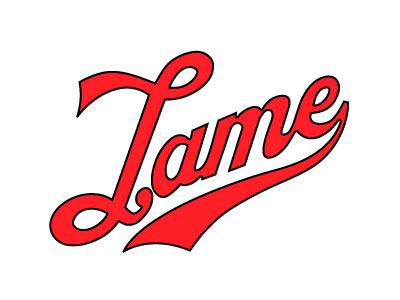
They went on to remake and copy my film. I wasn’t involved. In fact, I never even received a phone call from MGM or the producers of the new version of my movie. Such are the realities of Hollywood manners and American copyright law.
Fortunately the people who made the film were poor and hence the subsequent remake was awful.
I recently read that some TV reality show big-wig is remaking it yet again for MTV. The odd thing about plagiarism is that it is so frowned upon in every other area of the arts— even journalism. Not so with movies. Like an iPhone left on a restaurant table, it’s fair game for anyone who wasn’t taught by their parents, not to steal.
Mind you. To be honest, we can’t entirely take the moral high ground. We did nick the final conclusive finale from Jeff Lynne and, arguably, my title from David Bowie. But when someone steals your whole film it is akin to being mugged.
After, After, AfterWARDS
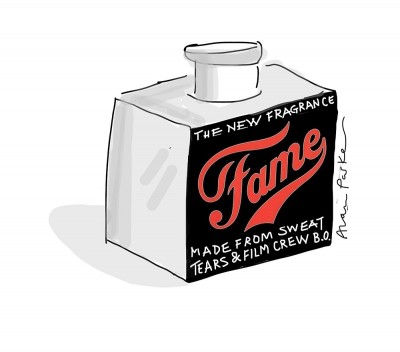
Fame, the film fragrance, made from the sweat, tears and film crew BO.
Lady Gaga brought out a perfume called ‘Fame’ which has not the slightest connection with our film. In fact, the New York summer of 1979, when the film was made, was one of the hottest and smelliest on record. As you crossed the street, the melting tar would ooze under your feet and my ‘lucky’ shirts, that had survived years of filming, suddenly rotted and fell apart. The smells of the film were not fragrant: the dancers’ sweat, the 46th Street uncollected garbage, the electricians’ body odor, the Broadway taxi fumes and that distinctive, foul smell that wafts up from the grills of the New York subway system, are my abiding nasal memories. I can’t imagine anyone wanting to bottle that.
All text © Alan Parker. All Fame photographs © MGM. Stills photography: Catherine Bushnell, Holly Bower Cinematographer: Michael Seresin
